Aloiampelos
Aloiampelos Klopper & Gideon F.Sm.
Family: Asphodelaceae
Common names: climbing aloes, rambling aloes, scrambling aloes (Eng.); rankaalwyne (Afr.)
Introduction
Rambling aloes, with their usually slender stems and thin, narrow, widely spaced leaves, form much-branched, robust, leaning to creeping shrubs. They can be used with great success in gardens as hedges and background plants in large beds, or even in medium-sized to large containers, from which they will happily grow onto a privacy screen or low pergola, for example.

Description
Description
All the representatives of this genus are characterised by being creeping, shrubby, or climbing succulent perennials. Leaves are spirally arranged, with a distinct sheath and separated by prominent internodes along the length of the mostly slender stems. Leaves are of medium length, rather narrow, thin, and unspotted, with only small, soft, harmless teeth on the margins. Leaf exudate is normally absent, or minimal and watery when present. Inflorescences are usually unbranched with lax to subdense cylindrical, or dense head-shaped racemes (flower heads). However, some forms of especially Aloiampelos ciliaris and A. tenuior can bear densely-flowered racemes, and if given horticultural attention in a garden setting, will often produce branched inflorescences (panicles). Flowers are rather small, cylindrical, sometimes banana-shaped, or with a slight constriction in the middle, and range from yellow through orange to red, and are often greenish-tinged.

Conservation Status
Status
Of the ten taxa in this genus, 4 are threatened, while the remaining 6 taxa are regarded as being of Least Concern (LC). Three of the threatened taxa, A. ciliaris var. redacta, A. commixta and A. decumbens, are assessed as being Vulnerable (VU), while the fourth, A. juddii, is Endangered (EN). The most noticeable threat to these plants is habitat loss, mostly as a result of alien plant encroachment, as well as land degradation, and illegal collecting. With the exception of A. ciliaris var. redacta, the other threatened Aloiampelos taxa essentially occur in the fynbos region of the Western Cape, an area in which winter rainfall predominates.
Distribution and habitat
Distribution description
Aloiampelos is comprised of 7 species of which one species has 3 varieties and another 2 varieties. The genus is endemic to South Africa, with most of the taxa occurring in the Western and Eastern Cape. One taxon (A. striatula var. striatula) also occurs on the Free State-Lesotho border and another (A. tenuior) as far northeast as the border of KwaZulu-Natal and Swaziland. Members of Aloiampelos grow in fynbos, forest, thicket, grassland or savanna vegetation. They are often found on the ecotone between different vegetation types and some taxa prefer rocky outcrops. They occur in both the winter and summer rainfall regions. While the distribution of most taxa in this genus is rather close to the coast, some of the species occur at higher altitudes inland, e.g. A. striatula.
Derivation of name and historical aspects
History
The name of the genus is derived from Aloe and the Greek word for a climbing plant (ampelos). This refers to the general climbing habit of the scrambling aloes. These plants were previously included in the genus Aloe, as Aloe section Macrifoliae (Haw.) Glen & D.S.Hardy.

Ecology
Ecology
Rambling aloes are pollinated by, amongst others, sunbirds. Plants are often visited by these and other birds when flowering. Since the stamens of many species of Aloiampelos are exserted from the corolla tube, these plants are also favoured by bees that collect pollen.
Uses
Use
Some species of Aloiampelos, for example A. ciliaris and A. tenuior, are widely used in horticulture. Aloiampelos tenuior is even commonly known as 'the gardener’s aloe'. Aloiampelos striatula is often planted as a hedge or boundary fence for properties or animal enclosures, especially in Lesotho. Large flowering clumps of virtually all the Aloiampelos species will attract birds (especially sunbirds) to a garden.

Growing Aloiampelos
Grow
Some of the scrambling aloes generally make attractive garden plants, provided that they have ample space to spread and that the often slender stems are supported by a nearby tree of shrub, or that the plants are allowed to form dense, self-supporting clumps. They can be successfully used as vertically trained, background plants in large beds. The easiest way to propagate the rambling aloes is with stem cuttings. Cuttings should be taken with a sharp knife or pair of secateurs and be allowed to dry in the shade for a few days before planting them directly in the garden where the plant is needed.
Aloiampelos ciliaris is one of easiest aloes to grow from cuttings that ideally should be initially provided with semi-shade, but plants will soon flourish in full sun. Plants benefit from being watered throughout the year. Aloiampelos striatula is frost hardy and can be utilised with success in gardens in areas with cold winters. However, it is often shy to flower in cultivation. It should be planted in heavy soil and watered well during summer. Aloiampelos tenuior flowers profusely in spring and summer, making it ideal for gardens in a mild climate. It prefers heavy soil and can tolerate some frost, but should be protected against wind, harsh sunlight, and severe frost. Aloiampelos commixta should be planted in sandy soils and watered well during the winter months. It is not very frost tolerant and should also be protected from direct sunlight. Aloiampelos gracilis should be planted in semi-shade in a rich, well-drained soil and watered throughout the year. It might not be possible, or very challenging, to successfully cultivate species that originate from the winter rainfall region in summer rainfall gardens.
Species
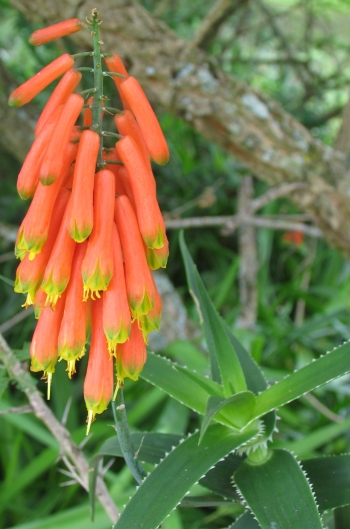
Aloiampelos ciliaris (Haw.) Klopper & Gideon F.Sm. var. ciliaris (= Aloe ciliaris var. ciliaris)
This tangled, climbing shrub has sheathing leaf bases that are collar-like, ciliate (with a fringe of hairs) and auriculate (ear-lobe-shaped). The green leaves are spreading to recurved. Racemes are short, broadly cylindrical and densely flowered. The bright red, cylindrical to slightly curved flowers are ± 30 mm long with pedicels (flower stalks) that can reach a length of 5–8 mm and are present throughout the year. This plant climbs through bushes, shrubs, and trees in bushland, wooded ravines and thickets of the coastal belt, and is always found near the sea in frost free areas. It only occurs in a narrow coastal strip from near Humansdorp to north of the Kei River Mouth, Eastern Cape, South Africa.
Aloiampelos ciliaris var. redacta (S.Carter) Klopper & Gideon F.Sm. (= Aloe ciliaris var. redacta)
The characters of A. ciliaris var. redacta are intermediate between those of the other 2 varieties of the species. However, it is not considered to be of hybrid origin. This climbing aloe flowers from November to April, and is considered to be Vulnerable (VU). It grows on sand dunes at the forest edge in a small area along the Kei River and around Qolora Mouth, Eastern Cape, South Africa.

Aloiampelos ciliaris var. tidmarshii (Schonland) Klopper & Gideon F.Sm. (= Aloe ciliaris var. tidmarshii)
A tangled, climbing shrub, where the sheathing portion of the leaf base is only very slightly auriculate (ear-lobe-shaped) and the margin very minutely ciliate (with a fringe of hairs). This variety of A. ciliaris is in all aspects smaller than the typical variety of the species. Racemes are sublaxly flowered and more narrowly cylindrical than those of var. ciliata. The red flowers (16–23 mm long) and pedicels (flower stalks) (4–6 mm long), are also shorter, and present from November to April. This variety grows on stony, clayey soils in relatively dense savanna woodland, at higher altitudes and further from the sea than A. ciliaris var. ciliaris. It is restricted to an inland strip of the Eastern Cape along the Zuurberg range, South Africa, and is endemic to the Albany Centre of Endemism.
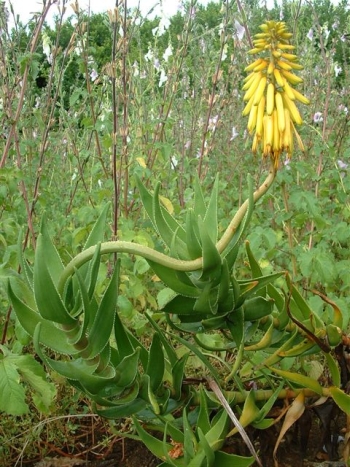
Aloiampelos commixta (A.Berger) Klopper & Gideon F.Sm. (= Aloe commixta)
The dull green leaves, with striatulate sheaths, of this branched, sprawling shrub are borne erectly (usually pointed towards the growing tip), not recurved. The peduncle (inflorescence stalk) is stout (15–17 mm in diameter) and bears a short, almost capitate (head-shaped), rather densely flowered, bicoloured raceme. Flowers are orangey-red in bud, but mature flowers are cylindrical, orange-yellow and 40 mm long, with pedicels (flower stalks) of 3–4 mm long. Plants flower from August to September. This creeping aloe is considered to be Vulnerable (VU) and is restricted to sandstone of the Table Mountain Group, where it grows between rocks and low shrubs in acidic soils, in an area of high winter rainfall, and close to the base of the summer mist belt. It is confined to the Cape Peninsula, Western Cape, South Africa.
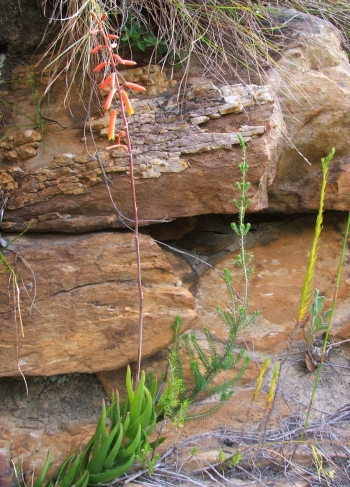
Aloiampelos decumbens (Reynolds) Klopper & Gideon F.Sm. (= Aloe decumbens)
This much-branched shrub has slender stems that are decumbent, but with the foliate portion held erect. The spreading leaves are bright green and faintly striate. The peduncle (inflorescence stalk) is slender (4–5 mm in diameter) bearing a sublaxly flowered cylindrical raceme. The red flowers are 28–33 mm long, cylindrical and slightly curved, with pedicels (flower stalks) of 4–5 mm long. Plants flower throughout the year, but flowering time is mostly between November and January. This species is considered to be Vulnerable (VU) and grows in South Langeberg Sandstone Fynbos on cliffs and steep north- and south-facing slopes, on sandstone of the Table Mountain Group. It is only known from the Langeberg (Riversdale region), Western Cape, South Africa.

Aloiampelos gracilis (Haw.) Klopper & Gideon F.Sm. (= Aloe gracilis)
The only faintly striated leaf sheaths of this much-branched shrub are not auriculate (ear-lobe-shaped) and lack ciliate margins. The dull green leaves are erectly spreading. Red flowers of 40–45 mm long, with pedicels ± 8 mm long, are borne in a laxly flowered, slightly conical (cone-shaped) raceme from May to August. This species grows in the ecotone between forest and fynbos at the eastern limit of the area that receives all season-rainfall. It typically occurs on stony places in thickets, along rocky hillsides and on steep rocky slopes of the coastal plain, or up to the top of the first range of mountains. It is only found in the Port Elizabeth and Joubertina areas, Eastern Cape, South Africa and is, therefore, more or less restricted to the Albany Centre of Endemism.
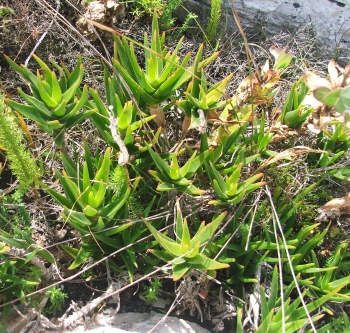
Aloiampelos juddii (Van Jaarsv.) Klopper & Gideon F.Sm. (= Aloe juddii)
This branched shrub has erect to somewhat creeping, densely foliate branches of ascending (upward curving), green leaves. The peduncle (inflorescence stalk) is robust (8–9 mm diameter) and bears sublaxly flowered, cylindrical racemes. Flowers are orange-red, 40 mm long, cylindrical and slightly curved, with 10–12 mm long pedicels (flower stalks). Plants flower in November. This Endangered (EN) species grows on southeast-facing rocky slopes on sandstone of the Table Mountain Group, in Overberg Sandstone Fynbos vegetation. It is thus far only known from the Baardskeerdersbos region east of Gansbaai (Overberg coastal mountains), Western Cape, South Africa.
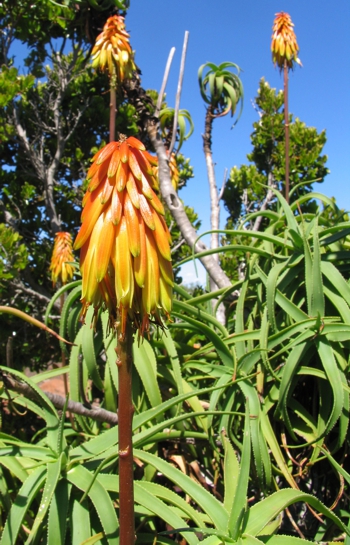
Aloiampelos striatula (Haw.) Klopper & Gideon F.Sm. var. caesia (Reynolds) Klopper & Gideon F.Sm. (= Aloe striatula var. caesia)
This aloe has a rambling growth form. Aloiampelos striatula var. caesia has more spreading, closely packed and more rosulate, shorter, greyish green leaves than A. striatula var. striatula. The leaf sheaths are also shorter and only obscurely lined. Racemes are narrow, cylindrical to cone-shaped, and relatively densely flowered. Flowers are short, straight, yellow, ± 30 mm long, and present from December to January. This rambling aloe grows among rocks on mountain tops within the winter snow belt. It only occurs in the west-central region of the Eastern Cape in the area between Queenstown, Cradock, and Middelburg, South Africa. It is restricted to the Albany Centre of Endemism.

Aloiampelos striatula var. striatula (= Aloe straiatula var. striatula)
This rambling aloe is the most robust member of the genus Aloiampelos. The recurved, shiny, dark green leaves have leaf sheaths that are distinctly longitudinally green-lined. Racemes are cylindrical to cone-shaped and relatively densely flowered. Flowers are slightly curved, reddish orange, 40–45 mm long and clasp the peduncle (inflorescence stalk). Flowering occurs mostly between October and November. This aloe grows among rocks on mountain tops within the winter snow belt in one of the coldest parts of southern Africa. It is distributed in the higher areas of the eastern and northeastern parts of the Eastern Cape, South Africa, and in southern Lesotho, with a disjunct distribution in the southeastern Free State, South Africa and western Lesotho.
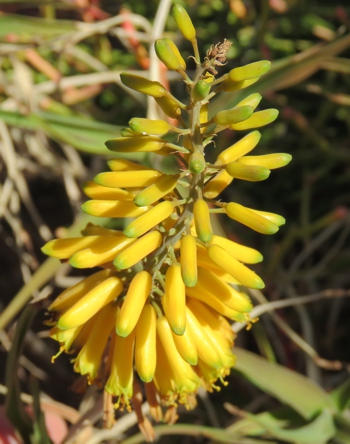
Aloiampelos tenuior (Haw.) Klopper & Gideon F.Sm. (= Aloe tenuior)
The fence aloe forms untidy shrubs, with a large subtuberous to woody rootstock. The erectly spreading leaves are blue-green and the leaf sheaths are not auriculate, but are obscurely lined, and often splits longitudinally. Elongated, rather densely flowered racemes with small, red, orange, or yellow cylindrical, straight flowers are mostly present from October to December. However, the flowering period is variable at different localities and appears to be dependent on rain. Aloiampelos tenuior is a very variable taxon and some of its extreme variants have been described as varieties, but these are generally not upheld. It grows in open country on sandy soil, rarely in valley bushveld, but sometimes on steep slopes. It occurs from the Port Elizabeth and Jansenville areas in the Eastern Cape into southern KwaZulu-Natal, with a disjunct distribution in northern KwaZulu-Natal at the Swaziland and Mpumalanga border, South Africa.
References
- Bornman, H. & Hardy, D. 1971. Aloes of the South African Veld. Voortrekker Pers. Johannesburg
- Grace, O.M., Klopper, R.R., Figueiredo, E. & Smith, G.F. 2011. The aloe names book. Strelitzia 28: i–viii.; 1–232. South African National Biodiversity Institute, Pretoria and the Royal Botanic Gardens, Kew.
- Grace, O.M., Klopper, R., Smith, G.F., Crouch, N.R., Figueiredo, E., RØnsted, N.E. & Van Wyk, A.E. 2013. A revised generic classification for Aloe (Xanthorrhoeaceae subfam. Asphodeloideae). Phytotaxa 76,1: 7–14.
- Red List of South African plants. 2017. Genus Aloiampelos. http://redlist.sanbi.org/genus.php?genus=15459. Accessed on 24 August 2017.
- Reynolds, G.W. 1950. The aloes of South Africa. Trustees of the Aloes of South Africa Book Fund, Johannesburg.
- Smith, G. 2003. First field guide to aloes of southern Africa. Struik Publishers, Cape Town.
- Smith, G.F. & Figueiredo, E. 2015. Garden aloes. Growing and breeding cultivars and hybrids. Jacana Media, Auckland Park.
- Smith, G.F. & Van Wyk, B. 2008. Aloes in southern Africa. Struik, Cape Town.
- Van Wyk, B. & Smith, G.F. 2014. Guide to the aloes of South Africa. Briza Publications, Pretoria.
Credits
Ronell R Klopper
National Herbarium, SANBI
and
Gideon F Smith
Department of Botany, Nelson Mandela University, South Africa
and Centre for Functional Ecology, Universidade de Coimbra, Portugal
October 2017
Acknowledgments: The authors thank John E. Burrows, Neil R. Crouch, Arrie W. Klopper and Ernst J. van Jaarsveld for supplying the images, as follows:
John E. Burrows: A. tenuior (plant)
Neil R. Crouch: A. ciliaris var. ciliaris (flowers); A. striatula var. caesia (plant and flowers); A. striatula var. striatula
Arrie W. Klopper: A. ciliaris (plant)
Ernst J. van Jaarsveld: A. commixta; A. decumbens; A. juddii
Other image credits:
SANBI Slide Collection, L.C. Leach: A. gracilis
Gideon F Smith: A. ciliaris var. redacta (sheath and flowers); A. ciliaris var. tidmarshii; A. tenuior (flowers)
Plant Attributes:
Plant Type:
SA Distribution:
Soil type:
Flowering season:
PH:
Flower colour:
Aspect:
Gardening skill:
Special Features:
Horticultural zones






Rate this article
Article well written and informative
Rate this plant
Is this an interesting plant?
Login to add your Comment
Back to topNot registered yet? Click here to register.